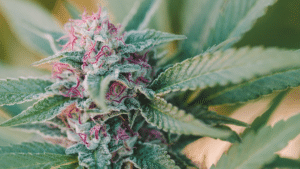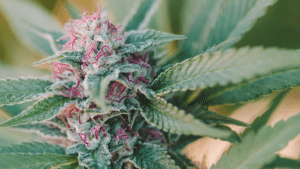
It has long been known that resinous cannabis flower tops are infused with robust therapeutic properties. But there are also pharmacologically active components in other parts of the plant that shouldn’t be ignored when assessing the health benefits of cannabis.
The earliest reference to the therapeutic use of cannabis dates back to 2700 BC in ancient China, “the land of hemp and mulberry.” Cannabis (“Ma”) was subsequently included in the Shennong Ben Cao Jing, humankind’s first pharmacopeia, which had been assembled by Emperor Shen Nung, the legendary father of traditional Chinese medicine, who is credited with introducing the custom of drinking tea. Ma was recommended for more than a hundred ailments, including gout, rheumatism, malaria, constipation, beri-beri, and absent-mindedness.
The Shennong Ben Cao Jing called Ma one of the “Supreme Elixirs of Immortality.” It was said to confer longevity and good health. If consumed over a long period of time, Ma could “enable one to communicate with the spirit light and make the body light. It mainly supplements the center and boosts the qi [chi]. Protracted taking may make one fat, strong, and never senile.”1
When consumed in excess, however, “it may make one behold ghosts and frenetically run about.”
Seeds of Health
In traditional Chinese medicine, protein-rich cannabis seeds figured prominently both as a food source and a remedy — apparently more so than resinous cannabis flower tops. The seeds don’t contain CBD, THC, or any other cannabinoids. But modern science confirms that cannabis seeds are an excellent source of omega 3 fatty acids, which are indispensable biochemical building blocks for a healthy endocannabinoid system.
A 2011 study published in Nature Neuroscience states: “Nutritional omega-3 deficiency abolishes endocannabinoid-mediated neuronal functions.”2 Low levels of omega-3 fatty acids have been linked to neuropsychiatric diseases and impaired emotional behavior.
Our endocannabinoids — the “marijuana-like” compounds that bind to the cannabinoid receptors CB1 and CB2, as well as other receptors in the brain and body — are actually derivatives or byproducts of omega 3 and omega 6 omega fatty acids. These are referred to as “essential” fatty acids because they can’t be produced by the body in adequate amounts and therefore must be ingested.
But the typical Western diet skews heavily toward corn, wheat, and other cereal grains, which are high in omega 6, whereas today we eat much less food — fish, nuts, leafy greens — that is rich in omega 3. This dietary imbalance is a major factor that contributes to many chronic diseases. It turns out that cannabis seeds (commercially available as hempseed oil, hemp hearts or hempseed protein powder) are gifted with an excellent balance of omega 3 and omega 6 fatty acids.
The Root of the Matter
Practitioners of traditional Chinese medicine also used an extract from raw cannabis roots to treat infections and to help women during childbirth. A decoction made by boiling the roots could be consumed orally as a tincture or juice or applied topically as a poultice.
Herbalists and healers have employed cannabis root preparations to treat a wide range of maladies not only in China but in other parts of the world. The first reference to the therapeutic properties of cannabis roots in Western medicine is found in the Natural Histories (77 AD) by Pliny the Elder. The Latin naturalist wrote that “the roots [of the cannabis plant] boiled in water ease cramped joints, gout too, and similar violent pain.”
As is the case with cannabis seeds, the roots don’t contain THC or CBD or any of the so-called minor cannabinoids. Nor are aromatic essential oils (which give cannabis flower its lively fragrance) present in the roots. Instead, the roots are endowed with other medicinal components that have analgesic and anti-inflammatory properties. Various alkaloids and sterols unique to cannabis roots are noteworthy antioxidants. Friedelin, a triterpenoid compound found in algae and lichen, as well as in cannabis roots, is known to reduce fevers.
A 12th century Persian medical text cited the antipyretic (fever-reducing) action of cannabis roots. And in 1542 the German physician Leonard Fuchs noted that a compress made with hemp root extract can soothe inflamed skin: “The raw root, pounded and wrapped, is good for the burn.” A hundred years later, English botanist John Parkinson recommended a decoction of hemp root “to cool inflammation of the head or any other part.” And Nicholas Culpepper’s Compleat Herbal, published in 1653, also mentions hemp roots as a remedy for inflammation.3
But keep in mind that cannabis is a bioaccumulator, meaning that its roots can draw heavy medals and other toxins from the soil. While that’s a great asset for cleaning up a contaminated ecosystem, it’s not what you want when growing an herb for human consumption. Where and how cannabis is cultivated are crucial factors that must be considered to avoid exposure to harmful material and to maximize the health benefits of the plant.
Flower Power
Cultivating high-quality cannabis isn’t rocket science, but it involves significant attention to detail. A hearty, adaptable plant that almost anyone can grow, cannabis lends itself to high-tech horticulture and sophisticated breeding methods designed to coax desired traits into prominence and fine-tune the quality of the high. The complexity of gourmet ganja — an adaptogen and euphoriant with an extraordinary range of smells and flavors and psychoactive subtleties — has reached a level of artistry comparable to today’s wine industry.
Growing the kindest bud ultimately depends on an ancient gardening ritual known as “sexing the plants,” a practice that entails separating male and female plants in their early stages to avoid pollination. Known as sinsemilla (Spanish for “without seeds”), the unfertilized female flower tops, oozing THC and CBD and a kaleidoscope of essential oils, are what cannabis is most famous for. The sexually frustrated females produce bigger buds with more sticky, aromatic resin in an unrequited attempt to catch pollen that never arrives.
Carl Linnaeus, the father of modern botany, wrote about this in his 1753 treatise Dissertation on the Sexes of Plants. The eminent Swedish scientist describes growing Cannabis sativa on his windowsill, an experience he greatly enjoyed:
“In the month of April, I sowed the seeds of hemp (Cannabis) in two different pots. The young plants came up plentifully . . . I placed each by the window, but in different and remote compartments. In one of them I permitted the male and female plants to remain together, to flower and bear fruit, which ripened in July . . . From the other, however, I removed all the male plants, as soon as they were old enough for me to distinguish them from the females. The remaining females grew very well, and presented their long pistilla in great abundance, these flowers continuing a very long time, as if in expectation of their mates . . . It was certainly a beautiful and truly admirable spectacle, to see the unimpregnated females preserve their pistilla so long green and flourishing, not permitting them to fade, till they had been for a very considerable time exploded, in vain, to access the male pollen . . .”4
Cannabis has been likened to a “pharmacological treasure trove.” CBD and THC are the crown jewels of this treasure trove. They are the power couple of cannabis therapeutics. But there are also dozens of secondary cannabinoids, terpenes, and flavonoids in the shimmering female inflorescence, each with specific healing attributes, which interact synergistically so that the therapeutic impact of whole plant cannabis is greater than the sum of its parts. From tap root to bud, whether seeded or seedless, the plant is the alpha and omega of cannabis medicine.
References
- Shou-zhong, Y. The Divine Farmer’s Materia Medica: A Translation of the Shen Nong Ben Cao Jing. Boulder, CO: Blue Poppy Press, 1997.
- Lafourcade M, Larrieu T, Mato S, Duffaud A, Sepers M, Matias I, De Smedt-Peyrusse V, Labrousse VF, Bretillon L, Matute C, Rodríguez-Puertas R, Layé S, Manzoni OJ. Nutritional omega-3 deficiency abolishes endocannabinoid-mediated neuronal functions. Nat Neurosci. 2011 Mar;14(3):345-50. doi: 10.1038/nn.2736. Epub 2011 Jan 30. PMID: 21278728.
- Ryz NR, Remillard DJ, Russo EB. Cannabis Roots: A Traditional Therapy with Future Potential for Treating Inflammation and Pain. Cannabis Cannabinoid Res. 2017 Aug 1;2(1):210-216. doi: 10.1089/can.2017.0028. PMID: 29082318; PMCID: PMC5628559.
- A Dissertation on the Sexes of Plants. Translated from the Latin of Linnaeus by James Edward Smith, F.R.S., into English and published 1786. Cited in Lee, Martin A. Smoke Signals. New York: Scribners: 2012, p. 22.
Martin A. Lee is the director of Project CBD. He’s authored and edited several books, including Smoke Signals, Acid Dreams, and The Essential Guide to CBD. © Copyright, Project CBD. May not be reprinted without permission.
The post The Plant, the Whole Plant & Nothing But the Plant appeared first on Project CBD.

